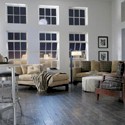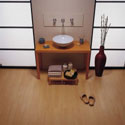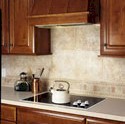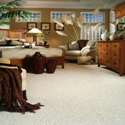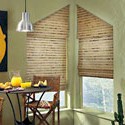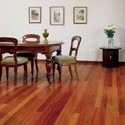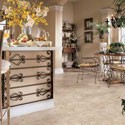| Start | Ideas | Articles | Books | Brands | Tools | Forum | Q & A | Local | Help | |||||||||||||||
|
|
| ||||||||||
Choosing the Perfect Flooring for Your Dining Room: A Guide to Style, Durability, and Comfort
Introduction
Selecting the right flooring for your dining room can transform it from a simple eating area into a stylish and functional space for gatherings, special occasions, and memorable moments. With so many options available—from hardwood to tile, carpet to vinyl—it’s important to choose a flooring that not only complements your dining room’s decor but also enhances its purpose. For many homeowners, the ideal dining room flooring balances style with durability, is comfortable underfoot, and requires minimal maintenance. In this guide, we’ll explore how different types of flooring can impact the overall aesthetic, functionality, and comfort of your dining room, with insights and expert advice to help you make the best choice.
1. Room Purpose
In a dining room, flooring must withstand frequent use, occasional spills, and heavy furniture. Choosing durable and easy-to-clean materials, such as hardwood or vinyl, can make hosting meals hassle-free. A resilient option that blends style with function ensures the flooring looks great for years, even with regular gatherings. Moreover, materials like engineered hardwood or waterproof vinyl are ideal, offering a refined appearance that accommodates both formal dinners and casual family meals.
2. Design Style
The flooring in your dining room should harmonize with its existing decor style—whether modern, traditional, or eclectic. For instance, hardwood floors bring warmth and a timeless charm that suits both classic and contemporary settings, while tile can introduce a Mediterranean or rustic flair. For a minimalist or industrial look, concrete or polished tiles may be ideal. By selecting flooring that complements the room’s color scheme, textures, and furniture, you can create a cohesive and welcoming environment that aligns with your unique style.
3. Durability
Dining rooms often endure high foot traffic, making durability a crucial consideration. Hardwood, particularly in finishes like oak or maple, is highly durable and can withstand years of use with proper care. Alternatively, luxury vinyl planks (LVP) provide the durability of hardwood with increased water resistance, making them an excellent choice for families with children. Investing in a durable flooring material will reduce the need for frequent replacements or repairs, making it a practical choice in the long run.
4. Moisture Exposure
Although dining rooms may not be as moisture-prone as kitchens, they are still susceptible to occasional spills. For this reason, it’s beneficial to choose flooring with some level of moisture resistance. Engineered hardwood or LVP are excellent options because they are less sensitive to moisture than solid hardwood. Additionally, they can be easily cleaned, protecting against stains and moisture damage that can affect certain flooring types.
5. Budget
Flooring can be a major investment, but there are options to fit a range of budgets. For example, while solid hardwood can be more expensive, LVP or laminate flooring provides a budget-friendly alternative that still achieves a high-end look. With so many options available, it’s possible to find a flooring style that meets your aesthetic and functional needs without stretching your budget too far.
6. Subfloor Condition
Before choosing a flooring material, it’s essential to assess the condition of your subfloor. An uneven subfloor may affect the installation and durability of certain types of flooring, such as tile or hardwood. However, vinyl and laminate are more forgiving when installed over slightly imperfect surfaces, offering a smoother finish without extensive preparation. Addressing any subfloor issues beforehand ensures a stable, long-lasting floor that enhances your dining room’s appearance and usability.
7. Eco-Friendliness
For eco-conscious homeowners, choosing environmentally friendly flooring is an important consideration. Options like reclaimed wood, cork, and bamboo offer sustainable choices with a stylish aesthetic. Cork, in particular, is comfortable underfoot and provides a natural insulation that enhances both comfort and warmth. Opting for eco-friendly materials can align with values of sustainability while creating a unique, visually appealing dining room.
8. Soundproofing/Insulation
The right flooring can influence a room’s acoustics, an essential factor in creating an enjoyable dining experience. Hard surfaces like tile and hardwood may amplify noise, while carpet or cork can dampen sound, creating a quieter atmosphere. Engineered wood and certain types of vinyl can also provide sound insulation, balancing aesthetics with acoustic comfort, especially for homes with open floor plans or adjoining living spaces.
9. Health Considerations
Certain flooring materials can affect indoor air quality, an important health factor for any living space. Materials like hardwood and cork are hypoallergenic and emit low VOCs (volatile organic compounds), contributing to a healthier indoor environment. Additionally, low-maintenance flooring that resists dust and allergens, such as vinyl, can make cleaning easier and improve air quality, creating a healthier home for you and your family.
Color Scheme and Visual Appeal
Flooring acts as a foundational element that ties a dining room's design together. Choosing a neutral or subtly patterned flooring can complement a wide range of color schemes, allowing flexibility in decor updates. Light hardwood floors, for example, can brighten the room and make it feel open, while darker tones like walnut add sophistication and warmth. The color and style of the flooring should enhance the dining room's overall aesthetic, creating a harmonious backdrop that lets other design elements shine.
Conclusion
Selecting the perfect flooring for a dining room involves balancing aesthetics, practicality, and durability. For a space that serves as the heart of family gatherings and dinners, flooring should be inviting and stylish while providing ease of maintenance. Options like hardwood, vinyl, and eco-friendly materials like cork each offer unique benefits suited to different design styles and functional needs. Whether you prioritize style, durability, or comfort, there’s a perfect flooring choice to meet your dining room's needs, making every meal a memorable experience.
These brands are a great starting point: Shaw Tile Flooring
![]() Room Ideas
Room Ideas
Not sure where to begin? Our Room Ideas Section is organized by rooms. Simply select the room you want to decorate and browse through hundreds of room scenes.
![]() News
News
Want to see what's new? Our News Section will brings you up to date information on brands, products, promotions and events.
![]() Books
Books
Our Books Section provides you in-depth customer reviews about books that contain information about . Find out what books are hot and what books are new.
![]() Brand Info
Brand Info
Use our Brands Section to browse different brands of . Click here to find the brand you want or be introduced to a new one.
![]() Design Tools
Design Tools![]()
Use a manufacturer's design tools to create a customized room scene using the products and styles offered by that manufacturer.
![]() F.A.Q's
F.A.Q's
Our F.A.Q.'s are answered by design and home improvement professionals. It features problems and solutions to various remodeling dilemmas.
![]() Local Directory
Local Directory
Looking for local retailer or installer of . Use our handy zip code locator or browse our directory by state and city.
